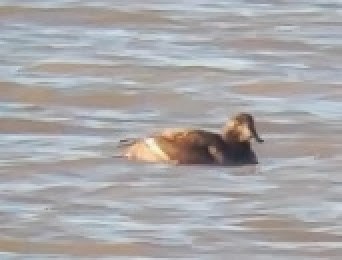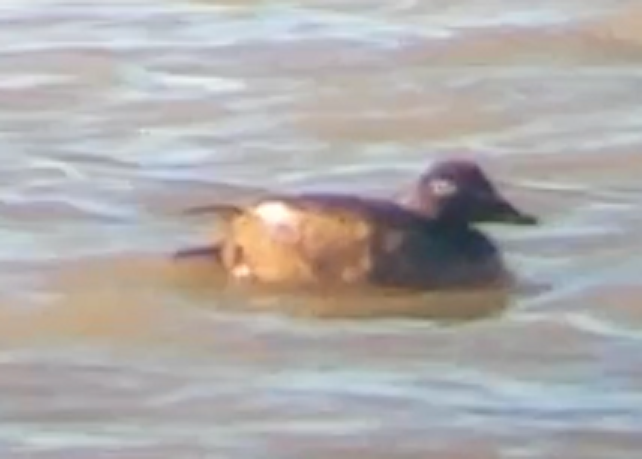...and it isn't even Mardi Gras yet.
January started off fairly typically, like the warm winters we’ve been having for
almost 20 years straight. In early January, I was driving around birding with Dave
Patton, and I worried aloud that we might not get another freeze for the
winter, and that the flowering plants in my yard would just keep getting
bigger. It’s been at least 3 years since
freeze had knocked them back, and the yard was a jungle. Little did I know what was to come.
Incidentally, as we drove home that day, I saw my first
Vermilion Parish Crested Caracara, or “Mexican Eagle,” as they’re called around
here. It was perched in a tree around
the cemetery that marks the spot of the former town of Cossinade (although it always
sounds like Cossinale to me when it’s said in French).
Historical note: Cossinade was the hub of the prairie area just
west of Kaplan back in the homesteader days of the late 1800s and early
1900s. It was even big enough to have a
church (Catholic; everyone was French).
However, when the railroad came through it passed to the south, and the
town of Kaplan was created on the rail line.
Cossinade couldn’t compete. Older people say the priest burned down the church at Cossinade so he could move to
Kaplan.
Now there’s just a cemetery there where folks like my
great-great uncle Demosthenes Trahan and his wife Azema Prejean, two of the
original SWLA Prairie homesteaders, spend their rest.
Rusty Blackbirds
One interesting side note for the winter has been the surge
in Rusty Blackbird numbers. At the
school where I teach, there’s been a resident flock since early January at
least. Heavy rains flood the playground,
and among the birds that flock to take advantage of worms and whatnot crawling
out of the flooded ground are a couple hundred Rusty Blackbirds. These birds are typically bottomland dwellers
here, and because their population is plummeting, they've become hard to find
lately. I track the numbers as well as I
can, but I’m on the job, not birding.
One morning I arrived early, and there was a group of over
100 Rusties feeding under the oaks by the driveway where parents line up to drop
their kids off for school. I greet the
families and open their car doors every morning, and since I was close to my
duty station and had a few minutes before the bell, I grabbed my binos and
camera to document the flock. I remember
that it was a frosty morning because I
had a new and very short haircut, my ears were getting pretty cold.
Long story short, when I went into the office after duty that morning, I
found out that one of the moms in the car line hadn't recognized the guy that had opened the
door of her truck for her daughter every day since August, and had called the office to let them
know a strange man with binoculars was taking pictures of the school*. The principal wanted to call 911 on the spot,
but the secretary told her to see if she could recognize the strange man. She couldn't.
Luckily the custodian told her, “It’s just Conover,” and I was able to
escape the shame of becoming a convicted birdwatcher.
My high count for Rusty Blackbirds at this spot this year
was 320. I hope that means Rusties are
doing better.
*She did the right thing, and I told her that and thanked her for her vigilance.
*She did the right thing, and I told her that and thanked her for her vigilance.
Freezes and Storms
By the end of January, I had to admit I was wrong when I’d
told Dave about another winter on its way out the door without a good freeze to
show for it. On January 21, temperatures
dropped and stayed below freezing through the next day. Rain fell and froze in layers, then pellets
of sleet fell and bounced off the ice. School was
closed, birds came in huge numbers for the seed I threw in the yard, and I
spent the day using blow-dryers and boiling water to keep the hummingbird
feeders thawed for my 5 winter hummers (3 Black-chinned and 2 Rufous). My son is doing a birdfeeding experiment for
science class involving suet use—and his suet blocks were in constant use. In a small backyard where the presence of 2
Orange-crowned Warblers normally leads to vicious combat, 4 Orange-crowneds
were pateintly queuing up to wait their turn to devour chunks of the lifesaving
fat. I don’t think politeness and
charity was on their minds; they were probably too starved for energy to waste
any on fighting.
 |
| The suet buffet, and a scene from a freeze. |
Another storm hit a week later, also bad enough to shut down
the town. Temperatures dropped to the high
teens or low 20s, and not much above above freezing for a few days. People who live where snow and freezes last
for months might chuckle at our weather wimpiness, but remember that SWLA is where their
birds come to get away from that weather.
The invertebrates that birds like wrens survive on are impossible to eat
when they’re trapped in ice, and small birds need a good supply of fuel to keep
themselves warm. The number of birds
that fell asleep on those cold nights and never woke again must have been staggering. Many species that are typically encountered
several times per hour during the normal course of birding disappeared almost
completely, while other species became remarkably scarce. I've seen only 3 House Wrens since the
freezes, Eastern Phoebes have disappeared from many spots, and Orange-crowned
Warblers and Ruby-crowned Kinglets, the core of many winter flocks, have
experienced huge losses. Desperate
flocks of Yellow-rumped Warblers fed on roadsides like sparrows, flushing in
groups of dozens.
 |
| Pine Warblers and American Goldfinches still seem to be in good numbers after the freezes. |
These weather events were much more brutal further north
across the continent, of course, and that probably caused the upswing we’ve
seen in waterfowl numbers. White-winged
Scoters are seemingly everywhere across the state, giving us a good chance to
study a bird that’s normally very rare in Louisiana.
 |
| White-winged Scoter sampler |
Nearshore Birding
On the coast, this is normally the hardest time of the year for birds. Gulls and pelicans can starve during normal winters here. I've seen many dead pelicans on the beach thus far, which is normal, and pelicans have been feeding in roadside borrow canals.
 |
| Three looks at Pomarine Jaegers, one with a full tail, a dark bird, and one with shorter popsicle-stick tail feathers. |
Jaegers are like the falcons of the sea. They fly in fast, find a gull with food, and
bully it into handing it over. It’s
fascinating to watch these birds engage in aerial combat, force a gull to
surrender its meal, and then catch the meal before it hits the waves. So fascinating, in fact, that Dave has become
an addict. When the weather is good, he
takes his boat to sea to see what he can find.
If the weather is good and it’s the weekend, I like to join him. Who knows what might come in from distant
seas?
 |
| White Pelicans and a Bonaparte's Gull on a gray day. |
I've been out with Dave in Cameron (out of the Calcasieu)
and Vermilion (out of Freshwater Bayou) parishes so far this winter. We've been lucky with jaegers. In Vermilion, with Judge Edwards, we got
great looks at several Pomarine Jaegers, as well as a quick pass by a gull that
looks good for Great Black-backed. Both
would be new for Vermilion Parish, I believe.
Dave has really opened a new chapter in Louisiana birding with his
frequent jaeger trips, showing that Parasitic Jaegers are regular at some times
of year, learning the habits of local Pomarine Jaegers, and meeting up with
some great birds over time (Razorbill, plus California, Glaucous, and Thayer’s gulls, and
of course, lots of jaegers). Even if no
rare birds are around, the boat provides different looks at common birds. Ever seen a pelican chase popcorn?
 |
| Marsh near Freshwater Bayou, Vermilion Parish |
Other Notes and Birds
There have been plenty of beautiful hawks to look at. Harlan's Hawks, Red-tailed hawks that are usually dark, have been easy to find. Paler Red-taileds have also been in good supply, with some stunning looking birds. The pale-headed Red-tailed Hawk below (not a great picture, sorry...but a great bird) has set up shop along Holly Beach in Cameron Parish.
 |
| Dark and pale Red-tailed Hawks. |
Another fine hawk has been present along Holly Beach, but it's been elusive. A Ferruginous Hawk has been seen there since early December, but not often. It either perches out of sight on the ground for much of the day, or comes and goes. Shawn Kurtzman spotted it this month, the first sighting since Dan O'Malley relocated it in late December. On a trip down a little after Shawn's sighting, I came across it as well. It's a large hawk that seems eagle-like in its bearing.
 So that’s where I am in the year. In a few days I’ll see my first Barn Swallow
of the spring, and soon after I’ll notice the lack of cranes and geese. Yellowtop and buttercup will cover the landscape,
and hot days will be tempered by chilly nights.
In less than a month, birding will switch back to coastal woodlots where
brightly colored warblers will light up the dull woods. Bitter as winter has been, it’s almost
spring.
So that’s where I am in the year. In a few days I’ll see my first Barn Swallow
of the spring, and soon after I’ll notice the lack of cranes and geese. Yellowtop and buttercup will cover the landscape,
and hot days will be tempered by chilly nights.
In less than a month, birding will switch back to coastal woodlots where
brightly colored warblers will light up the dull woods. Bitter as winter has been, it’s almost
spring. 














